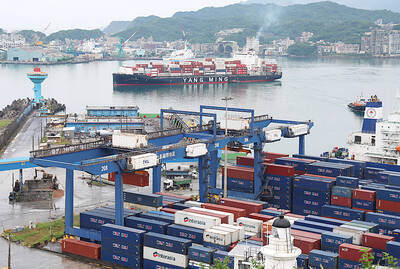An ongoing labor shortage in hotels and restaurants is due to low wages rather than imbalanced supply and demand, the Ministry of Labor said yesterday.
The ministry made the remarks after Grand Hyatt Taipei (台北君悅大飯店) general manager Will Chen (陳慶隆) on Wednesday told reporters that the five-star facility is looking at a rapid recovery in business next year.
However, the lack of staff is slowing the pace, he said.

Photo courtesy of Caesar Park Hotels and Resorts
Formosa International Hotels Group (晶華酒店集團) chairman Steve Pan (潘思亮) earlier said its flagship property, the Regent Taipei (台北晶華酒店), had to turn down reservations for thousands of banquet tables due to understaffing.
About 58 hotels have about 380 vacant positions, but only 37.4 percent meet wage expectations, the ministry said, adding that there is ample room for improvement if companies want to resolve the situation.
The ministry said it had launched rounds of matching campaigns, and concluded that wage expectation gaps account for the understaffing issues in the hospitality sector.
Hotels have pressed the government to ease regulations regarding hiring migrant workers, as it is currently limited to the manufacturing, construction, agriculture and fishing sectors, as well as caretaker positions.
The service sector comprises 60 percent of employment in Taiwan, and there are many potential workers available locally to work at hotels and restaurants, the ministry said.
Hospitality operators should lower their qualification requirements or raise compensation to attract applicants to vacancies, it said.
Dependence on low-paid migrant workers is not healthy for the industry or society, it added.

CHIP RACE: Three years of overbroad export controls drove foreign competitors to pursue their own AI chips, and ‘cost US taxpayers billions of dollars,’ Nvidia said China has figured out the US strategy for allowing it to buy Nvidia Corp’s H200s and is rejecting the artificial intelligence (AI) chip in favor of domestically developed semiconductors, White House AI adviser David Sacks said, citing news reports. US President Donald Trump on Monday said that he would allow shipments of Nvidia’s H200 chips to China, part of an administration effort backed by Sacks to challenge Chinese tech champions such as Huawei Technologies Co (華為) by bringing US competition to their home market. On Friday, Sacks signaled that he was uncertain about whether that approach would work. “They’re rejecting our chips,” Sacks

Taiwan’s exports soared 56 percent year-on-year to an all-time high of US$64.05 billion last month, propelled by surging global demand for artificial intelligence (AI), high-performance computing and cloud service infrastructure, the Ministry of Finance said yesterday. Department of Statistics Director-General Beatrice Tsai (蔡美娜) called the figure an unexpected upside surprise, citing a wave of technology orders from overseas customers alongside the usual year-end shopping season for technology products. Growth is likely to remain strong this month, she said, projecting a 40 percent to 45 percent expansion on an annual basis. The outperformance could prompt the Directorate-General of Budget, Accounting and

NATIONAL SECURITY: Intel’s testing of ACM tools despite US government control ‘highlights egregious gaps in US technology protection policies,’ a former official said Chipmaker Intel Corp has tested chipmaking tools this year from a toolmaker with deep roots in China and two overseas units that were targeted by US sanctions, according to two sources with direct knowledge of the matter. Intel, which fended off calls for its CEO’s resignation from US President Donald Trump in August over his alleged ties to China, got the tools from ACM Research Inc, a Fremont, California-based producer of chipmaking equipment. Two of ACM’s units, based in Shanghai and South Korea, were among a number of firms barred last year from receiving US technology over claims they have

BARRIERS: Gudeng’s chairman said it was unlikely that the US could replicate Taiwan’s science parks in Arizona, given its strict immigration policies and cultural differences Gudeng Precision Industrial Co (家登), which supplies wafer pods to the world’s major semiconductor firms, yesterday said it is in no rush to set up production in the US due to high costs. The company supplies its customers through a warehouse in Arizona jointly operated by TSS Holdings Ltd (德鑫控股), a joint holding of Gudeng and 17 Taiwanese firms in the semiconductor supply chain, including specialty plastic compounds producer Nytex Composites Co (耐特) and automated material handling system supplier Symtek Automation Asia Co (迅得). While the company has long been exploring the feasibility of setting up production in the US to address